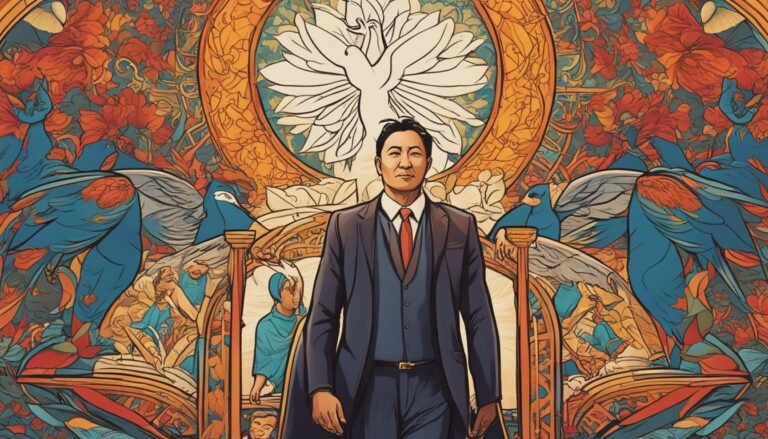Leadership Conflict Resolution: Building Harmony
“In the midst of chaos, there is also opportunity.” – Sun Tzu
Conflict happens in every team. But as leaders, we must steer through these tough times. We need to turn these clashes into chances for our team to grow and work well together. Solving conflicts well can make our bonds stronger. It can also boost new ideas and teamwork.
By learning ways to manage conflicts and being good leaders, we can make our workplaces better places. Here, problems are sorted out in a way that makes everyone feel heard and valued.
Key Takeaways:
- Conflict is a natural part of any team’s journey
- Effective conflict resolution leads to growth and collaboration
- Equipping leaders with conflict management strategies is crucial
- Building a harmonious work environment fosters innovation and productivity
- Conflict resolution transforms challenges into opportunities
Importance of Open Communication in Conflict Resolution
Open communication is key in solving conflicts well. When team members can freely talk about their issues, problems can be solved in a good way. This happens when everyone listens carefully, shows they understand, and talks openly. This helps create a space where people work together to solve problems in a positive way.
Leaders need to show how to listen and understand others. They should lead by engaging with what their team has to say and really caring about their ideas. This makes people feel safe talking about what’s bothering them, leading to solving problems better.
When everyone openly shares their thoughts, new solutions can come up. This sharing of ideas can lead to more creative ways to solve problems. It turns conflicts into chances for everyone to learn and grow.
Effective communication is the bedrock upon which constructive conflict resolution is built. When team members feel heard, valued, and respected, they are more likely to engage in productive discussions, seek common ground, and work towards mutually beneficial solutions.
Active Listening and Empathetic Communication
Active listening and empathetic talk are important in conflict resolution. Active listening means really concentrating on the speaker and trying to get their point of view. That validation and understanding are crucial. Empathetic communication means trying to understand the other person’s feelings and responding with kindness.
When leaders show they are good listeners and caring, it sets a good example. Everyone starts to treat problems with more understanding, kindness, and respect.
The Power of Open Communication
Open communication does more than just solve fights. It also makes teams trust each other more and feel like they really belong. This kind of talking helps teams find the real root of their issues. That way, they can stop these problems from coming up again.
It also makes everything clear and honest. This means fewer misunderstandings and more work getting done well. Openness lets everyone give and get advice, which helps people grow and get better at what they do.
| The Benefits of Open Communication in Conflict Resolution |
|---|
| Enhanced understanding and empathy |
| Increased problem-solving ability |
| Improved teamwork and collaboration |
| Greater trust and transparency |
| Identification of underlying issues |
| Enhanced learning and personal growth |
Working on open communication is always needed. It’s about making sure everyone feels respected and able to speak up. By working together like this, leaders help their teams grow and do great things together.
Empowering Through Conflict Resolution Training
Getting conflict resolution training helps team members learn important skills. They learn negotiation skills, problem-solving techniques, and how to cool things down. These skills help turn problems into chances to get along and grow.
This training teaches folks to negotiate well. It’s key for settling differences and finding deals that work for all. Team members learn to agree and build strong relationships.
It also gives them strong ways to tackle problems. They learn to look at issues, find answers, and solve problems fairly and well. This makes the team stronger.
Leaders are big in making their teams good at solving conflict. They must show they’re good at handling issues too. By always getting better at conflict-resolution skills, leaders help make a friendly workplace for all.
This kind of training doesn’t just give tools and tips. It also makes working together and talking openly a bigger part of the team’s vibe. Employees get to share their views, understand each other, and find ways that work for everyone.
Effective conflict resolution training empowers individuals to address conflicts head-on, confront challenges with confidence, and find innovative solutions that contribute to the overall success of the team.
Investing in conflict resolution training helps teams see conflict as a way to get better and not just as a problem. This kind of learning makes team members ready to face tough situations. They turn hard times into good ones.
Incorporating Conflict Resolution Training:
Here are some steps for making conflict resolution part of your organization:
- Offer workshops and seminars to boost negotiation skills and improve problem-solving techniques.
- Get team members to take conflict resolution courses and share what they learn.
- Encourage everyone to talk openly. See conflict as a way to get better together.
- Keep helping with more training and tools to keep the peace.
Focusing on conflict resolution training makes the workplace better. It helps solve issues well, makes friendships stronger, and boosts teamwork.
Establishing Clear Conflict Resolution Protocols
To tackle conflicts in a team, setting clear resolution protocols is key. These guides help manage conflicts in a fair way. They offer steps to follow, assign roles for resolving fights, and set deadlines. This way, teams solve issues in an orderly and quick manner.
Openness is vital for successful conflict resolution. It’s important to share these guidelines with everyone. This builds a common understanding and clear rules for all team members. With these known procedures, team members can deal with disputes confidently, trusting the process.
Sticking to these rules shows how crucial it is to address conflicts early. The detailed process in the protocols helps teams treat conflicts fairly. This creates a work setting where solving problems together makes the team stronger and more cooperative.
Conflict Resolution Techniques for Leaders
Leaders are crucial in teaching teams how to handle conflicts well. They do this by using methods that boost talking, giving training on handling fights, and laying down clear rules. These steps help turn fights into chances to grow and work together better.
Active listening is a vital tool for resolving conflicts. When you really listen to your team members and show you care about their view, you make it easier to talk openly and understand each other. This way, you get to the root of the problem and can agree on how to move forward.
Another great skill is to summarize each person’s point of view. After someone speaks, you repeat back what they said. This shows you took the time to hear them, you know their issues, and respect their view. It helps to build trust and move towards sorting things out.
Making employees feel secure is key while solving conflicts. Creating a positive, welcoming space cuts down on fear and makes people more likely to share. Let everyone know their input is important, which helps build an atmosphere of trust and teamwork.
Encouraging feedback that’s helpful is also vital. Leaders do this by setting up ways for people to give their thoughts without fear, having regular feedback meetings, or using surveys. This kind of feedback lets team members share their worries and ideas for getting better in a way that’s helpful and kind.
Mind that working on resolving conflicts never stops, and leaders should always improve their skills in this area. By enhancing how they lead, getting everyone to talk openly, and using good ways to resolve conflicts, leaders can make a place where people work together well, come up with new ideas, and get along smoothly.
Managing Conflict as a CEO
CEOs need to be good at dealing with conflict. It’s vital to tackle problems directly and lower the chances of them happening at work. This way, a company can have a peaceful atmosphere where teamwork and getting things done is easier.
When there’s a conflict, listening to all sides is key for CEOs. They must understand what everyone thinks. This makes sure everyone’s opinions are respected and helps in reaching solutions.
Giving power to employees to solve problems is important. By showing support, CEOs make it okay for workers to talk about their issues and work together to fix them. It leads to better understanding and stronger bonds among the team.
Clear communication is crucial for managing conflict. CEOs must set expectations, help where needed, and provide a way for everyone to talk openly. It builds a place where honesty and trust are the norm. Keeping calm and being fair helps make better choices during tough times.
CEOs should set rules for solving conflicts. This way, everyone knows how decisions are made, which makes things fair. It also makes sure that problems get fixed quickly, stopping them from getting bigger.
CEOs should always keep improving how they handle conflicts. Going to training, talking to other CEOs, and staying up to date helps. They’ll get better at making their workplace a great place to be.
“Conflict management is not about avoiding conflicts, but rather about addressing them productively and transforming them into opportunities for growth and improvement.” – John Chambers
Key Takeaways:
- Address conflicts head-on and take proactive steps to reduce their occurrence
- Listen to all parties involved and summarize different perspectives
- Empower employees to find common ground and work towards resolution
- Communicate effectively, control emotions, and provide decision-making guidelines
- Establish protocols for addressing conflicts promptly and fairly
- Continuously develop leadership skills in conflict management
| Common Challenges for CEOs in Conflict Management | Effective Strategies for CEOs in Conflict Management |
|---|---|
| Lack of open communication | Promote transparency and encourage open dialogue |
| Difficulty in understanding different perspectives | Actively listen and validate each person’s viewpoint |
| Emotional reactions and personal biases | Maintain objectivity and approach conflicts with empathy |
| Unstructured conflict resolution processes | Establish clear guidelines and protocols for addressing conflicts |
| Inconsistent decision-making | Provide a structured framework and be fair in decision-making |
Benefits of Conflict Management Training
Conflict management training is great for both people and companies. It helps businesses make a more peaceful work atmosphere. This is where workers can do their best. Now, let’s see some big pluses of this kind of training.
Improved Communication and Collaboration
Training in conflict management boosts how well people talk. They learn to share their ideas clearly and to really listen. This makes teaming up better, helping everyone find solutions that work for all.
Enhanced Problem-Solving Skills
After this training, folks are better at solving issues. They get good at figuring out why things go wrong, coming up with ideas, and choosing the best plan. It’s not just for fixing fights. These skills help with all kinds of work problems, making things run smoother.
Fostering Positive Workplace Relationships
Training in handling fights helps coworkers get along better. It shows them how to deal with problems nicely, with kindness and respect. This way, by solving problems calmly, people trust each other more.
Contributing to a Productive Work Environment
This kind of training makes workplaces more efficient. When issues get solved fast and nicely, it keeps work on track. People can focus better on their job. So, learning how to solve problems well cuts down on work problems.
| Benefits of Conflict Management Training | Keywords |
|---|---|
| Improved Communication and Collaboration | communication, collaboration |
| Enhanced Problem-Solving Skills | problem-solving skills |
| Fostering Positive Workplace Relationships | workplace relationships |
| Contributing to a Productive Work Environment | productivity, office culture |
Conflict management training brings lots of good changes to a company. It helps people share what they think and solve problems well. As a result, workplaces become better for everyone.

Image Caption: Conflict management training offers numerous benefits for individuals and organizations, fostering effective communication, collaboration, and problem-solving skills.
Impact on Workplace Relationships
Conflict management training makes a big difference in how well people get along at work. It teaches employees how to deal with problems in a way that doesn’t harm their relationships. This helps build trust, clear communication, and understanding among coworkers. It also helps improve how well people talk and work together.
Solving conflicts well leads to better connections between employees, where they support each other. This leads to a place of work where people are happy to help out. Together, this makes the workplace better and helps everyone work together more effectively.
Learning to solve problems creatively is another key outcome of this training. It pushes people to look at issues from different angles. This approach encourages fresh thinking and the birth of new, smart ideas.
This kind of training is also good for personal growth. It helps everyone learn how to deal with tough situations in a healthy way. This can make you better at understanding others, talking to them, and handling different emotions. These are skills that can help at work and in your personal life.
In general, investing in conflict management training is a win for everyone. It makes the office a place where people learn from disagreements. It creates an encouraging workplace where everyone feels connected and can grow together.
Effect on Productivity and Office Culture
Workplace conflicts hurt productivity and the feel of the office. They bring troubles and make team bonds weak. But, with good ways to solve conflicts, companies lessen these bad outcomes. They can create a workplace where everyone feels part of a team.
The Impact on Productivity
Unsettled work conflicts really harm how much work gets done. Team members stop focusing on tasks because they’re in conflict. This mess leads to projects not finished on time and a lower overall output.
Teaching how to resolve conflicts helps a lot. It gives employees tools to solve fights quickly. This way, they can get back to work without lingering issues getting in the way.
Fixing conflicts also boosts how much work a team does together. They start working well with positive ties. A company that values talking openly and respecting others turns conflicts into chances for better teamwork and new ideas.
The Influence on Office Culture
Work fights can make an office really gloomy. They sour the atmosphere and, if not fixed, they spread negativity. This affects how happy, trusting, and satisfied everyone is with their job.
Yet, teams that concentrate on solving issues and understanding each other create a pleasant and welcoming place. Here, they learn to manage conflicts well. Employees get to talk openly and find fair solutions, which make everyone feel more in control.
A nice office vibe is all about everyone working together, helping each other, and showing respect. Resolving conflicts builds trust. It makes a place where people are valued and want to do their very best.
Conclusion
Conflict management training is crucial for a peaceful work setting. It equips staff with skills to handle problems. This improves how they talk, solve issues, and get along. Training makes the workplace positive and more productive.
This type of training teaches staff ways to solve problems. They learn to listen, talk with others in a caring way, and negotiate. With these tools, conflicts are resolved in ways that help everyone. This makes working together better and more successful.
Also, the training builds trust and respect in teams. It makes speaking freely easier, which is good for everyone. People can openly share thoughts and work together better because of it.
To sum up, training to manage conflicts is key for a good work environment. It helps teams deal with issues well, making things better. This way, dealing with disagreements is a chance for everyone to grow and succeed.
FAQ
How can leaders promote open communication for conflict resolution?
Leaders foster open talks by listening and showing they care. They encourage employees to see problems as chances to get better.
How can conflict resolution training benefit teams?
Training helps team members learn important skills like discussing, solving problems, and calming situations down. It helps them see issues in a way that they can solve and grow from.
Why is it important to establish clear conflict resolution protocols within teams?
Having clear steps to follow for dealing with issues is important. These steps define how to handle conflicts, who does what, and how long it should take. This clarity helps when issues come up.
What are some effective conflict resolution techniques for leaders?
Leaders can resolve conflicts well by listening carefully, understanding, and showing support. They should also encourage sharing of ideas and feedback. This creates a team-focused and positive work space.
How should CEOs manage conflicts in the workplace?
CEOs need to deal with issues directly and fair. They should listen to all sides, understand different views, and encourage finding common ground. Good communication, staying calm, and setting clear decision- making rules are keys to success.
What are the benefits of conflict management training?
Conflict training makes communication better and teamwork stronger. It teaches new ways to solve problems and builds good relationships at work. Team members can share thoughts openly and learn to fix issues in a positive way.
How does conflict management training impact workplace relationships?
Conflict training boosts trust and respect among coworkers. It encourages clear communication and understanding. Solving problems in a positive way makes the work atmosphere better and team work stronger.
What is the impact of workplace conflicts on productivity and office culture?
Conflicts at work can lower productivity and spoil the office vibe. But, with proper training, these downsides can be turned around. Training helps make working together better, building a more peaceful and united work place.
How does conflict resolution contribute to a harmonious work environment?
Teaching employees how to handle conflicts in a positive way can greatly help. It makes them communicate better, solve issues, and build happier work relationships. This investment leads to a more positive work space where growth and new ideas can flourish.








